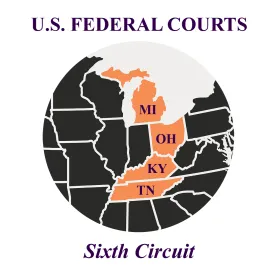Multiple groups of petitioners in the newly consolidated litigation and renamed challenge to the OSHA ETS, now known as the “OSHA Covid Rule Case,” Docket No, 21-7000, MCP No. 165 (6th Cir.) have asked the court to hear the OSHA challenge en banc, with all active judges in the circuit. Multiple groups of petitioners have made or joined other groups’ requests, including a coalition of 27 states as well as the Republican National Committee (RNC). These petitioners argue that the case involves a question of “exceptional importance” involving constitutional questions about appropriate delegation of authority to OSHA, the Commerce Clause, and state versus federal powers under the 10th Amendment. The answers to these questions will affect about 80 million people in this country and their right to make personal healthcare decisions. The petitioners also argue that the OSHA ETS conflicts with Supreme Court and 6th Circuit precedent in cases heard earlier this year on the CDC's eviction moratorium. See, e.g., Alabama Assoc. Realtors et. al v. HHS, 594 U.S. ___(2021) (“[T]he sheer scope of the CDC’s claimed authority under §361(a) [of the Public Health Service Act] would counsel against the Government’s interpretation. We expect Congress to speak clearly when authorizing an agency to exercise powers of “vast ‘economic and political significance.’”); Tiger Lily v. HHS, 5 F.4th 666 (6th Cir. 2021) (holding “CDC cannot nationalize landlord-tenant law” without “exceedingly clear language” from Congress).
The RNC in particular argues that the White House has created uncertainty regarding compliance with the ETS because in a press briefing on November 18, 2021, the Press Secretary told businesses to move forward with compliance and stated "that we are still heading toward the same timeline" notwithstanding the 5th Circuit's stay of the ETS. The RNC stated that this uncertainty comes at a time when it is about to hire 300 employees in preparation for the 2022 election cycle and thus, “the uncertainty created by the Administration’s action threatens ‘an irreversible . . . election,’ ” which is why the 6th Circuit should hear the case en banc.
Federal appellate cases are normally heard by a three-judge panel selected at random. The losing side may then petition for rehearing en banc, meaning that all of the active circuit judges would review the case and a majority of those could overturn or affirm the decision of the three-judge panel, prior to petitioning the Supreme Court for review.
Rule 35 of the Federal Rules of Appellate Procedure is a special procedure that allows parties to request, in rare circumstances, that the circuit bypass the normal three-judge panel and have the case initially heard by all the active judges.
Having the case heard en banc initially will promote judicial efficiency because the decision of a three-judge panel would likely result in a request for a rehearing en banc anyway. The OSHA ETS is hotly contested and politically charged, as evidenced by the various petitioners on both sides of the issue that have filed 34 petitions to review the ETS in 12 federal judicial circuits. The government has until November 30, 2021, to file one consolidated response to all the petitions for the case to be heard en banc.
Meanwhile, the government has filed an Emergency Motion to Dissolve Stay, citing numerous errors with the 5th Circuit’s analysis. The government argues, among other things, that:
-
the 5th Circuit erred in its findings that an airborne virus like COVID-19 did not meet the definitions of “physical agent” and “new hazard,” in the OSH Act;
-
contrary to the 5th Circuit’s findings, OSHA has the authority to regulate hazards that also exist outside of the work environment.;
-
the ETS does regulate economic activity under the Commerce Clause because it is regulating conditions of employment for business that affect interstate commerce;
-
the 5th Circuit got it wrong when finding that the government did not properly explain its change in position on the necessity of an ETS from last year when it told the D.C. Circuit in May 2020 that it did not need an ETS to address the COVID-19 hazard; and
-
the difference between then and now is that this ETS is narrowly tailored to the COVID-19 hazard and is not seeking to regulate some generic and undefined category of infectious diseases without notice and comment rulemaking, which is what was in dispute in the 2020 D.C. Circuit case.
In addressing the 5th Circuit’s concern about the ETS arbitrarily regulating employers with 100 employees or more but not smaller employers, the government argues that it is proceeding in a “stepwise fashion,” and is considering that option still, which does not undermine the ETS as currently written. The government further argues that COVID-19 does still pose a grave danger because unvaccinated people can become seriously ill and still die and “the existence of a ‘grave danger’…does not mean that the worst-case scenarios certain to befall every employee.” The OSHA Covid Rule, Docket No. 21-700, Entry [69], p. 31 (6th Cir). The government argues that on balance, the risk to employees in staying the ETS outweighs the harm to petitioners of compliance with the ETS and “would likely cost many lives per day, in addition to large numbers of hospitalizations other serious health effects and tremendous expenses.” Id. at 41.
Lastly, the government argues that if the 6th Circuit disagrees that the stay should be lifted, the Court should modify the stay so that the masking and testing requirements can remain in effect during the pendency of the litigation. Id. at 48. The government also argues that the stay should be limited to the affirmative requirements imposed on employers, and that they should be left with the option to adopt COVID-19 policies. Id. at 50. Finally, the government seeks clarification on the scope of the 5th Circuit’s stay, should the 6th Circuit leave it in place, because the 5th Circuit ordered OSHA to take no steps to implement or enforce the ETS. Specifically, the government requests the ability of OSHA to provide pre-enforcement guidance to the public and take internal steps, such as drafting guidance and training employees on enforcement of the ETS during the pendency of the litigation. Id. at 53.




 />i
/>i

